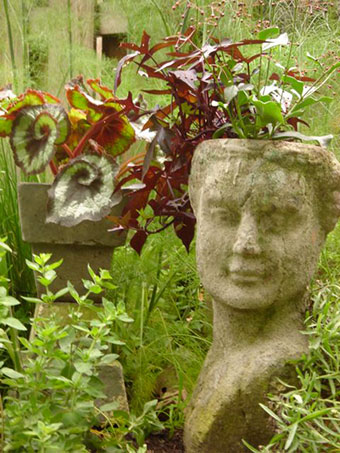






By Monique Watts for Artvoice
Container gardening has many advantages. For those without a yard or with a very small space or even for those who have physical limitations that keep them from being able to maintain a large garden, planting in pots can satisfy the need to have your hands in the dirt as well as provide a practical solution for having flowers to enjoy and herbs and vegetables for the table.
In addition, plants can be moved to catch the best sun throughout the day and containers generally won’t need weeding. Monitoring moisture and ensuring they are planted in vessels with nutrient rich soil and have proper drainage is about all that is required. Plants in containers aren’t able to dig down deep with their roots in search of water, so if only one task is heeded, let it be consistent watering.
The sky is the limit on the type of containers to plant. It is sometimes easier to choose the plants for a container rather than the other way around. Recycled items such as tires, old shoes, a leaky watering can, an old wheelbarrow or wagon, kitchen pots, and old dishes can serve the purpose. Before you put to the curb an unused drawer or wooden crate, consider its planting possibilities. Avoid anything that might have residues of toxins or lead-based paint. And you can search for salvaged materials such as discarded pots that may be chipped or weathered but can add character to your collection. Planting lettuce in a kitchen colander, chamomile in a chipped tea cup, or a succulent-based rock garden in an old wooden salad bowl will be the beginnings of great garden stories. And if you are really industrious, learn to make your own hypertufa containers—to learn how, visit http://www.finegardening.com/how-to/articles/make-hypertufa-trough.aspx.
Being able to change the look of a garden area by shifting and adding containers and plants as the seasons change is another great benefit. Collect photographs of plant groupings that you like for inspiration. Choose plants that share requirements for sun, soil, water and heat. Consider plants that are drought tolerant, but don’t be afraid to experiment with others that might be more moisture needy. Take into account size of your container and growing area needs of your plants. Select plants based on height and color that will compliment the container. All types of plants, herbs, vegetables and flowers can be part of a container garden. Trees, shrubs, and vines can be added for height and screening. One advantage is that we can grow lemon trees and tropicals that if planted in the ground not over weather in our zone. You can extend the growing season of tender lettuces by growing them in pots and shifting into sunny, but cooler areas, as the weather gets warmer. Gail Johnstone, a Buffalo resident living in a condominium, chose to grow lettuce in a self-watering trough. “I think this is the best lettuce I’ve ever grown and it is the closest thing to a garden we’ve had since 1979 when we lived in a home with a yard in Pittsburgh,” she said.
A few of my favorite container garden combinations are: black magic elephant ear surrounded by a rustic orange coleus and chartreuse hakone grass in my large bright blue ceramic pot; fiber optic grass and junkus-corkscrew surrounded by blue-tone hens and chickens in an old wooden salad bowl; dwarf conifers in a box-shaped hypertufa container.
For more ideas and growing fun, join us at Urban Roots on July 10, when Dave Clark will host a do-it-yourself workshop where you can make your own container garden.
Read more: http://artvoice.com/issues/v9n25/sprouts_and_roots#ixzz10xJImngL
Copyright © www.100flowers.win Botanic Garden All Rights Reserved